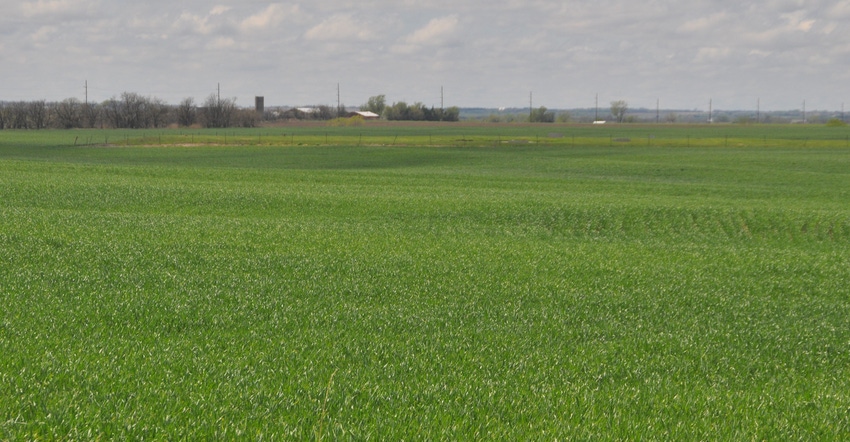
Wheat stem rust falls into the bucket of diseases that are often classified as “defeated,” says Erick DeWolf, Kansas State University Extension plant pathologist. However, he warns, complacency about the disease isn’t a good idea, and the dangerous pest could make a comeback if producers plant too many acres in varieties that are not resistant.
“Our last big outbreak of stem rust was back in 1986 and 1987,” he says. “We haven’t had a problem in decades because we have varieties with excellent genetic resistance to this disease. Back in the 1980s, we had a high number of acres that were planted to varieties that are not resistant. Unfortunately, I’m seeing those acres on the rise again and it is worrisome.”
DeWolf says it is not uncommon to still see stem rust in isolated pockets in the state, but it is usually at low levels.
“It makes it easy to become complacent,” he says. “I’m concerned that people will forget how damaging this disease can be an open themselves up to problems. If varieties susceptible to stem rust take more and more acres, we have an emerging danger.”
According to the Kansas Wheat Alliance, western Kansas has more than 30% of its acres planted to stem rust susceptible varieties this year. Although the spotlight is on western Kansas, it isn't the only region DeWolf is concerned about. Ten percent of central Kansas acres are also planted to stem rust susceptible wheat varieties.
Acres planted to susceptible wheat varieties are also increasing in Colorado, Oklahoma and Texas. The increased susceptibility of wheat in Texas is particularly important. The rust disease of wheat often survives the winter in parts of Texas and Mexico.
"Once the disease gets established in northern Texas and southern Oklahoma," DeWolf says. "They are often moved North by storm systems into our area."
Past stem rust outbreaks in the Great Plains were triggered by a small area of susceptible wheat planted in Texas.
"We're well beyond just a few acres now,” DeWolf says. “This is not just one grower that is raising susceptible varieties. The risk could be much greater now than most growers in the Great Plains have experienced in over 40 years.”
DeWolf says Kansas isn't the only area in the world experiencing the threat of a stem rust outbreak. Western Europe, the United Kingdom, Germany and Sweden have all reported increased activity of stem rust, after not seeing the disease for many years, like the United States.
"Ecuador, part of South America, has a new race of stem rust that's able to overcome some types of genetic resistance widely used in Kansas,” he says. “This race of stem rust could be a threat if it moves from South America to Central America, then to the U.S.”
In the future, growers should focus on varieties that are well adapted to their region, but also have a strong resistance to the disease.
"I would encourage growers to try and avoid planting highly susceptible varieties where possible," he says.
Growers can find information about stem rust susceptibility in K-State's Wheat Variety Disease and Insect Ratings Guide. Varieties with ratings of 8 or 9, indicating a high level of susceptibility, should be avoided.
Speaking of more immediate solutions, DeWolf says if there happens to be a stem rust outbreak this growing season, a fungicide treatment could help reduce the yield losses caused by the disease. Adding stem rust to the list of problems already affecting wheat production in Kansas will likely increase the cost of production and complicate the management of other diseases.
For example, the timing of fungicides to control stem rust is often later than it is for many other foliar diseases of wheat. Fungicide applications optimized for stripe rust control may not provide enough protection against stem rust.
For growers looking for varieties that fit well in western and central Kansas, all K-State wheat varieties have solid resistance to stem rust. Some of the more notable ones include Larry, Tatanka, Joe, Zenda, KanMark and Oakley CL.
You can learn more about these varieties, along with other K-State wheat varieties, on the Kansas Wheat Alliance website at kswheatalliance.org.
Prospects for 2019 wheat harvest are looking good
Turning to the topic of the condition of the 2019 hard red winter wheat crop, DeWolf says that the wheat is in excellent condition across much of Kansas.
“I’ve seen some excellent fields,” he says. “There are some fields that were planted very late that are struggling. They were slow to emerge in the cool, wet soils of last fall and they had no time to tiller out in the fall. They are struggling to get a good growth pattern established now.”
DeWolf was scouting fields in south-central Kansas during the last week of April and says he was surprised to see that the wheat crop is about on schedule for maturity.
“I really expected to see a lot of fields that would indicate a late harvest,” he says. “But I’m seeing a lot of flag leaf emergence and that’s just about right on schedule for the end of April.”
A plus for most fields in a very good moisture profile, DeWolf says.
“Most of the state has had good, even excessive, winter and spring moisture,” he says. “That’s gives us promise of very good yields.”
While he is on the lookout for the fungal diseases that tend to be a bigger problem in years with cool, wet conditions, he has not seen significant disease pressure so far, DeWolf says.
About the Author(s)
You May Also Like






